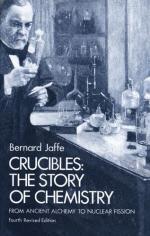|
This section contains 2,468 words (approx. 9 pages at 300 words per page) |

|
Nuclear fission is a process in which the nucleus of an atom splits, usually into two daughter nuclei. Spontaneous fission of uranium and other elements in Earth's interior provides an internal source of heat that drives plate tectonics. Fission tracks in mineral crystals, a result of spontaneous fission of uranium, can be used in radiometric dating of rock and rock layers.
Long before the internal construction of the atom was well understood in terms of protons, neutrons, and electrons, nuclear transformations that resulted in observable radioactivity were observed as early as 1896 by French physicist Henri Becquerel (1852–1908). In 1905, British physicist Ernst Rutherford (1871–1937) and American physicist Bertram Borden Boltwood (1870–1927) first used radioactive decay measurements to date minerals.
The fission reaction was discovered when a target of uranium was bombarded by neutrons. Fission fragments were shown to fly apart with a large release of energy. The fission reaction was...
|
This section contains 2,468 words (approx. 9 pages at 300 words per page) |

|


